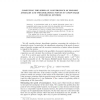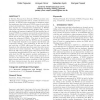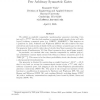13214 search results - page 9 / 2643 » Pseudorandomness for network algorithms |
CORR
2010
Springer
14 years 11 months ago
2010
Springer
A pseudorandom point in an ergodic dynamical system over a computable metric space is a point which is computable but its dynamics has the same statistical behavior of a typical po...
MOBIHOC
2004
ACM
15 years 11 months ago
2004
ACM
A Wireless Personal Area Network (WPAN) provides wireless links among proximate devices, usually carried by an individual. As WPAN gains momentum in ubiquitous usage, the interfer...
90
Voted
EUROCRYPT
1999
Springer
15 years 4 months ago
1999
Springer
Abstract. This work describes schemes for distributing between n servers the evaluation of a function f which is an approximation to a random function, such that only authorized su...
86
Voted
COCO
2005
Springer
15 years 1 months ago
2005
Springer
We exhibit an explicitly computable ‘pseudorandom’ generator stretching l bits into m(l) = lΩ(log l) bits that look random to constant-depth circuits of size m(l) with log m...
84
Voted
APPROX
2004
Springer
15 years 5 months ago
2004
Springer
A quantum encryption scheme (also called private quantum channel, or state randomization protocol) is a one-time pad for quantum messages. If two parties share a classical random s...




